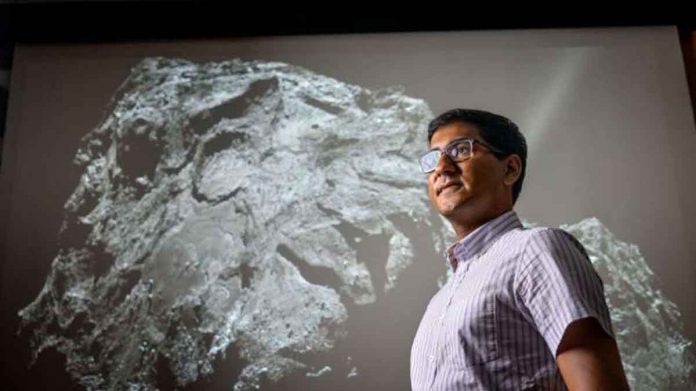Cornell astronomers have demonstrated how smooth terrains—a good place to land a spacecraft and scoop up samples—evolve on the icy world of comets, with an eye toward a possible return mission years in the future.
They show that the topography influences the surface activity of the barbell-shaped Comet 67P/Churyumov-Gerasimenko across hundreds of metres by applying thermal models to data collected by the Rosetta mission, which caught up to the comet almost a decade ago.
The findings were published in The Planetary Science Journal on August 16.
“On comets, you can have a uniform surface composition and still have hotspots of activity,” said lead author Abhinav S. Jindal, a graduate student in astronomy and member of Alexander Hayes’ research group in the College of Arts and Sciences. “The activity is being driven by the topography.”
Comets, according to Jindal, are icy bodies composed of dust, rocks, and gas that remained after the solar system formed about 4.6 billion years ago. They form on the outskirts of the solar system and have spent all of eternity cruising through the dark, cosmic freezer of space, far from the sun’s heat.
“Their chemistry hasn’t changed much since comets formed, making them ‘time capsules’ preserving primordial material from the birth of the solar system,” Jindal explained, adding that these bodies most likely seeded early Earth with water and key building blocks of life.
“”As some of these comets are drawn into the inner solar system,” he explained, “their surfaces change.” Science is attempting to comprehend the driving processes.”
As Comet 67P loops back toward the sun every 6.45 years, the body speeds by it to a point known as perihelion—its closest approach—and the comet warms up. The Rosetta mission tracked and studied the comet as it orbited the sun. The smooth terrains are where the most changes were observed, making them critical to understanding the evolution of the surface.
Jindal and his colleagues studied the evolution of 16 topographic depressions in the Imhotep region—the largest smooth terrain deposit on 67P—between June 5, 2015, when activity was first detected, and December 6, 2015, when the final large-scale changes were detected.
The comet went through a process known as sublimation, in which the icy parts became gaseous in the heat of the sun. The smooth Imhotep region of the comet displayed a complex pattern of eroding scarps (the steep edges of arc-shaped depressions) and material deposition.
The Rosetta mission of the European Space Agency launched in March 2004, carrying a comet-landing craft named Philae. Rosetta waited its turn by exploring Mars and a few asteroids, and a decade later, it arrived at Comet 67P to accompany the object as it rounded the sun. Its smaller, drone-like Philae probe landed on the comet in late 2014, and Rosetta sank to the surface in late 2016.
Jindal believes that science will return to Comet 67P one day. “These comets are assisting us in determining where we came from,” he said.

